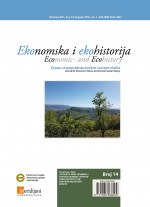THE INTERRELATION OF WOOD REQUIREMENTS OF THE AUSTRIAN NAVY AND THE SHAPING OF THE CULTURAL LANDSCAPE IN THE NORTHERN ADRIATIC REGION
THE INTERRELATION OF WOOD REQUIREMENTS OF THE AUSTRIAN NAVY AND THE SHAPING OF THE CULTURAL LANDSCAPE IN THE NORTHERN ADRIATIC REGION
Author(s): Elisabeth JohannSubject(s): Modern Age, Recent History (1900 till today), Environmental and Energy policy, Socio-Economic Research
Published by: Društvo za hrvatsku ekonomsku povijest i ekohistoriju - Izdavačka kuća Meridijani
Keywords: deforestation; timber; forest degradation; afforesting; shipyard;
Summary/Abstract: The Austrian Navy dates back to the 16th century and expanded in the first decades of the 19th century. Before the beginning of World War II it had its peak and ranged on the 6th place in the world. The end of the Austro-Hungarian Monarchy also concerned the destiny of the navy as it was dissolved in 1918. Only some warships remained controlling parts of the river Danube, finishing their service in 2006. The most important harbours were Trieste (today Italy), Pula (today Croatia), Rijeka (today Croatia) and Venice (toady Italy). The paper deals with the procurement of timber for the supply of the Austrian navy in the first half of the 19th century. It investigates the effects of the increasing demand on the shaping of the cultural landscape of the Northern Adriatic region. In particular forest management taking into account socio-economic and socio-ecologic aspects and working plans for the re-cultivation of the Karst region are discussed. Although the importance of timber for shipbuilding has vanished today, the shape of the wooded landscape in the hinterland of Trieste, Rijeka and Senj, and Istria is a vivid witness of the historical interdependencies of sea and land.
Journal: Ekonomska i ekohistorija - Časopis za gospodarsku povijest i povijest okoliša
- Issue Year: 2018
- Issue No: 14
- Page Range: 32-51
- Page Count: 20
- Language: English

